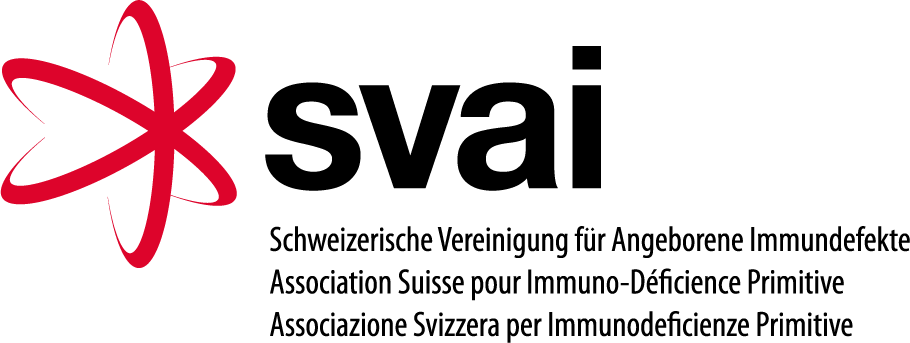
Primary immunodeficiency:
types, symptoms and treatment
People suffering from a primary immunodeficiency are prone to infections from birth. Their bodies have no resistance to pathogens such as viruses and bacteria. This form of immunodeficiency is rare and incurable. But it can be treated.
In primary immunodeficiency (PID), the immune system is weakened from birth (= primary). The immune deficiency (immune insufficiency) prevents the immune system from successfully defending itself against pathogens such as viruses and bacteria. The weakened immune system puts the sufferer at risk of a large number of infectious diseases.
In addition to congenital primary immunodeficiencies, there is also an acquired (secondary) immunodeficiency, which develops, for example, after a serious illness. Primary immunodeficiency is less common than secondary immunodeficiency. In Switzerland, an estimated 1,200 children and adults are affected by primary immunodeficiency.
Even if the primary immunodeficiency (PID) is congenital, it is seldom possible to detect whether an immune deficiency is present in infants. The weak immune system often only becomes apparent in adulthood.
There is no one single primary immunodeficiency with a disease that develops from it; instead, primary immunodeficiency can take a wide range of forms. The symptoms of PID can therefore be manifested in a wide range of symptoms and diseases, such as frequent colds, pneumonia, meningitis, bacterial gum inflammation (periodontitis) and other infections in the mouth, but also in the form of cancer or autoimmune diseases.
In children, certain infections suggest a primary immunodeficiency, including:
- Eight or more purulent middle ear infections per year
- Having pneumonia two or more times per year
- Having sinusitis two or more times per year
In adults, for example:
- Four or more infections treated with antibiotics per year
- Having pneumonia two or more times within three years
- Two or more serious bacterial infections (e.g. blood poisoning, meningitis)
Primary immunodeficiency is genetic. More than 400 genes are known in which defects weaken the immune system and pave the way for a variety of diseases. Because of this diversity, many cases of primary immunodeficiency are only detected at a late stage.
Important elements of the immune defences that may be impaired with PID are:
- B lymphocytes: a lack of these white blood cells facilitates bacterial infections, for example.
- T lymphocytes: if too few of these white blood cells are present, this promotes viral infections.
- Phagocytes: these scavenger cells – also white blood cells – fight bacteria, fungi and parasites.
- Antibodies (immunoglobulins): these molecules also fight off pathogens. There are different sub-forms such as IgG or IgA. In the case of a deficiency of immunoglobulins, doctors speak of hypogammaglobulinaemia.
There are many forms of primary immunodeficiency. Among the most well-known are the following:
- When certain defects of T cells and B cells (T lymphocytes, B lymphocytes) occur together, this is referred to as a severe combined immunodeficiency (SCID, pronounced “skid”). SCID makes pathogens that cause few problems for people without a primary immunodeficiency particularly dangerous.
- Common variable immune deficiency (CVID) is a congenital antibody deficiency. It often leads to infections of the ears and respiratory tract.
- Louis Bar syndrome is a defect of the B cells and T cells. This primary immunodeficiency often manifests itself in the form of movement disorders in young children.
To do this, patients are treated with immunoglobulin therapy. Antibodies obtained from the blood plasma of healthy people are injected into the vein (intravenous) or under the skin (subcutaneous infusion). An advantage of subcutaneous therapy is that patients can treat themselves.
The limitations in everyday life that primary immunodeficiency entails are just as varied as the symptoms. Many sufferers live a normal life, participate in sports and travel. However, a doctor should be consulted as it is important not to overburden the immune system.
For more information and support services, please visit:
- S2k-Leitlinie der Deutschen Gesellschaft für Immunologie e.V. (DGfI): Diagnostik auf Vorliegen eines primären Immundefektes (PID) (Stand: Oktober 2017)
- Kinderspital Zürich: Immunologie, unter: www.kispi.uzh.ch (Abrufdatum: 14.11.2022)
- Universitätsspital Zürich: Immundefekte, unter: www.usz.ch (Abrufdatum: 14.11.2022)
- Göschl, L., Vossen, M.: Diagnostik und Therapie bei primären Immundefekten / „inborn errors of immunity“. Wiener klinische Wochenschrift Education; 14; 65–79 (2019)



